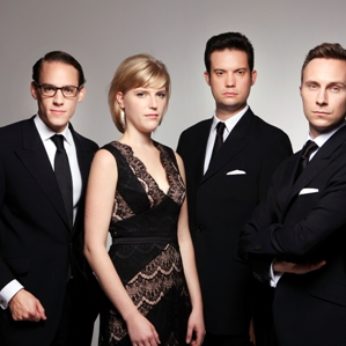Composer: Erich Korngold (b. 1897 - d. 1957)
Performance date: 29/06/2014
Venue: Bantry Library
Composition Year: 1921-22
Duration: 00:32:51
Recording Engineer: Richard McCullough, RTE
Instrumentation Category:Piano Quartet/Piano Quintet
Instrumentation Other: pf, 2vn, va, vc
Artists:
Julius Drake -
[piano]
Doric String Quartet (Alex Redington, Jonathan Stone [violins], Hélène Clément [viola], John Myerscough [cello]) -
[quartet]

He has so much talent that
he could easily give us half – and still enough left for himself!
Giacomo
Puccini on Korngold [1916]
Erich
Korngold grew up in the artistic hot-house of pre-War Vienna. He was the son of
the most influential music critic in the city, who arranged for the
ten-year-old prodigy to study with Zemlinsky. By the time he was thirteen, he
was famous all over Europe and at seventeen his operatic double bill Polykrates and Violanta was premiered almost simultaneously at Munich and Vienna
to standing ovations and sold out performances. In 1920 Die Tote Stadt opened simultaneously in Hamburg and Cologne,
swiftly followed by Vienna, Dresden and New York.
Meanwhile
the young composer had fallen in love and, as in all good stories, the parents
did everything they could to keep them apart. She was Luzi von Sonnenthal and a
talented singer and musician, who could follow the coded musical messages
Korngold wrote into his works. He wrote
Abschiedlieder for her and one of the songs, Mond, so gehst du wieder auf, whose melody is his Luzi theme,
reappears to great effect in the Piano Quintet’s Adagio. The Quintet itself,
also composed during their separation, is in three complex movements and is
fearsomely difficult to play.
The
work opens with a typical Korngold upwardly leaping melody and proceeds with
dancing rhythms and richly decorated textures abounding with the composer’s
sunny and sensual disposition, where moments of deep romantic seriousness can
be dismissed with an airy wave. The powerful opening leads into a complex
transition before the cello sings out the glorious second theme. The development works through all the
many ideas as though the five players were an entire orchestra including the
entire range of the piano’s expressive possibilities.
The
Adagio is a heartfelt love-song from one young lover to the other. Structurally
it is a set of nine free variations on the theme from Mond, so gehst du wieder auf, but the other three songs from the Abschiedslieder cycle all make an appearance along with the
lovers’ secret code. The music shifts the key down to D major to present the
lovers’ tender theme, gradually rising to bring in the rich sound of the full
quintet. At times the music seems in danger of disintegrating in the embrace of
so much loving introspection, but Korngold moves quietly on to the next
variation, all the while demonstrating his complete mastery of late Romantic
harmonies. The tranquillity of the opening is restored in the final bars and
the movement closes on a mysterious unresolved chord.
After
a striking declamatory opening based on the Abschiedlieder
theme and a mini-cadenza for violin, the Allegro giocoso picks up a lively theme that moves from one
brilliant episode to the next in an increasingly wild combination of variation
and rondo. The work is brought to an end by a decisive re-appearance of the
opening theme from the first movement.
Copyright © 2024 West Cork Music. All rights reserved.
Designed and developed by Matrix Internet